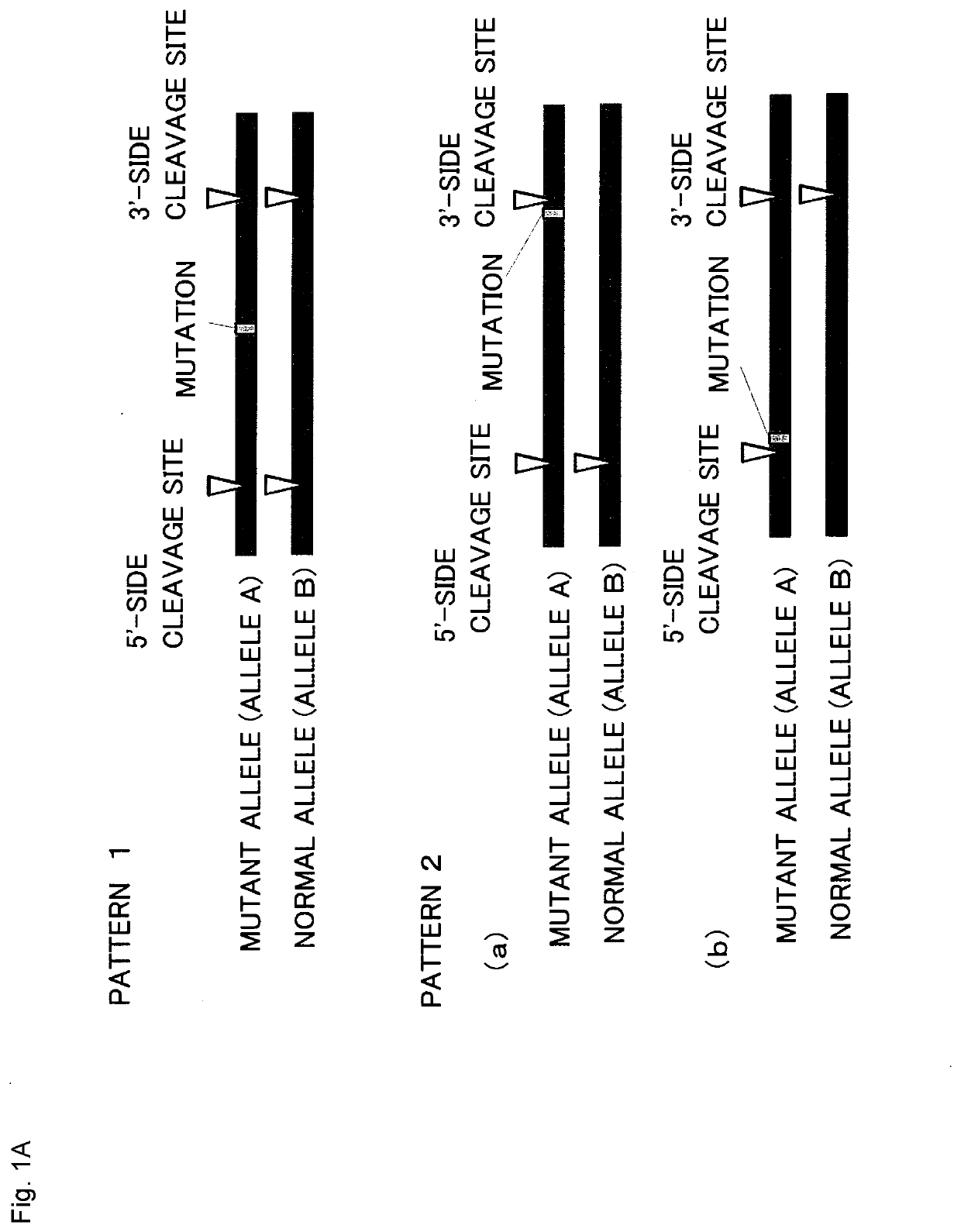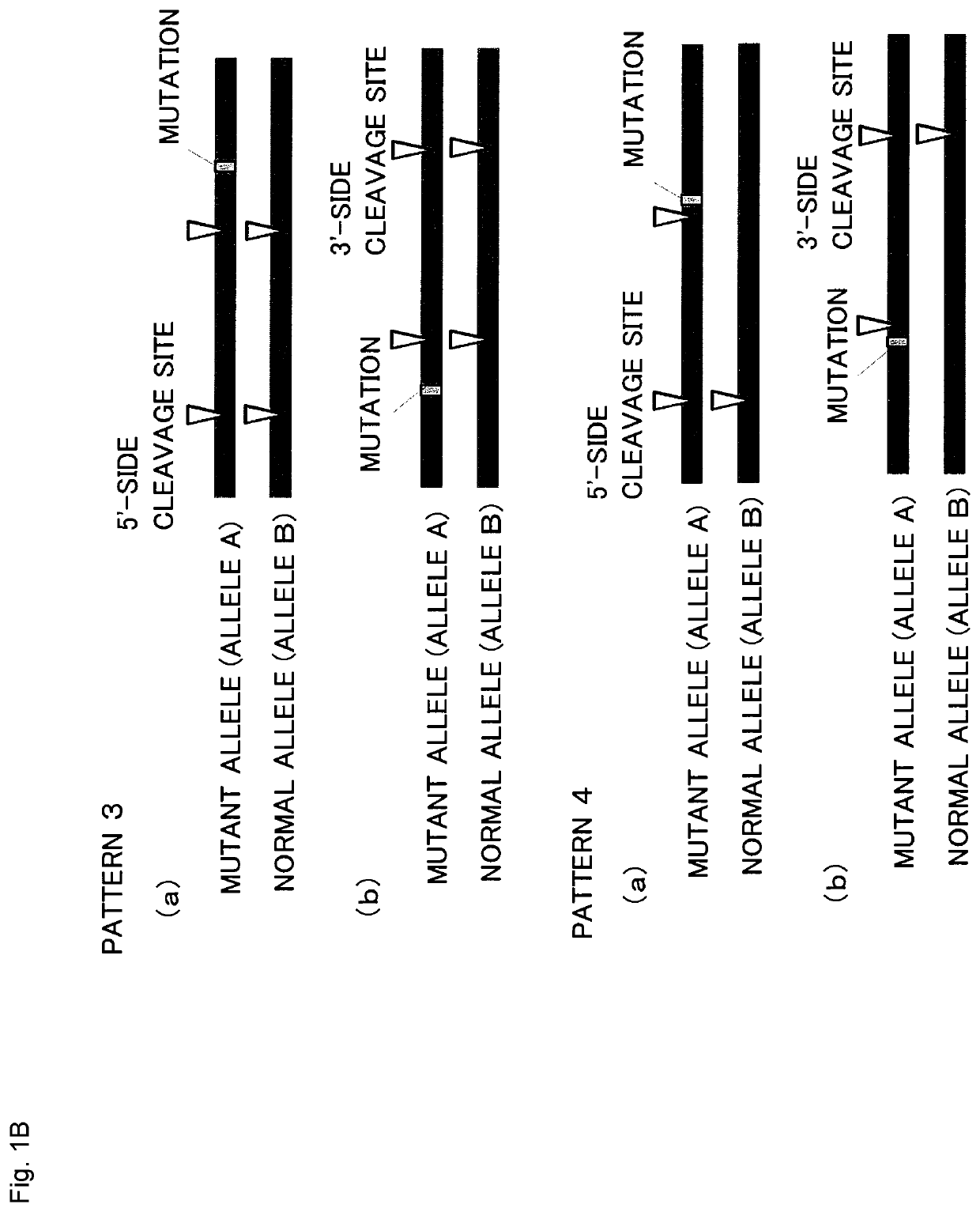Method for producing genome-edited cell
a genome-edited cell and cell technology, applied in the field of genome-edited cell production, can solve the problems of genomic mutation, unintended mutation, genome editing using programmable nucleases, etc., and achieve the effects of suppressing the occurrence of unintended mutations, high efficiency, and high safety
- Summary
- Abstract
- Description
- Claims
- Application Information
AI Technical Summary
Benefits of technology
Problems solved by technology
Method used
Image
Examples
example 1
[Example 1] Effectiveness of Multiple-Nick Method
A. Materials
[0080](1) TSCER2 Cells
[0081]These are cells derived from lymphoblast TK6 cells (1-nucleotide inserted into exon 4, frameshift) having a heterozygous mutation in the thymidine kinase 1 gene (TK1) Thirty-one base pairs were inserted into intoron 4 of a healthy allele (which itself has nothing to do with loss of TK1 gene function) and a mutation was inserted into exon 5 to modify into a complex heterozygous mutation, resulting in loss of the functions of the TK1 gene. Since the DNA synthesis salvage pathway dependent on thymidine kinase does not function, when the DNA de novo synthesis pathway is blocked by aminopterin, cells cannot proliferate even when 2-deoxycytidine, hypoxanthine, and thymidine are supplied. When the thymidine kinase activity is restored by genome editing, cell proliferation becomes possible even in CHAR medium (10 μM 2-deoxycytidine [Sigma], 200 μM hypoxanthine [Sigma], 100 nM aminopterin [Sigma], and 17...
example 2
[Example 2] Verification of Effect of Distance between Nicks on Genome Editing Efficiency
A. Materials
[0100]The vectors used in the present example are shown below.
VN1: PX461(Cas9D10A-P2A-GFP)-TSCER2_TK1(ex4)20s
VN2: PX462(Cas9D10A-P2A-PuroR)-TSCER2_TK1(ex4)20s
VN3: PX462(Cas9D10A-P2A-PuroR)-TSCER2_TK1(ex4)-322s
[0101]VN4: PX461(Cas9D10A-P2A-GFP)-empty
VN5: PX462(Cas9D10A-P2A-PuroR)-empty
VS1: PX462(Cas9D10A-P2A-PuroR)-TSCER2_TK1-S1
VS2: PX462(Cas9D10A-P2A-PuroR)-TSCER2_TK1-S2
VS3: PX462(Cas9D10A-P2A-PuroR)-TSCER2_TK1-S3
VS4: PX462(Cas9D10A-P2A-PuroR)-TSCER2_TK1-S4
VS5: PX462(Cas9D10A-P2A-PuroR)-TSCER2_TK1-S5
VS6: PX462(Cas9D10A-P2A-PuroR)-TSCER2_TK1-S6
VS7: PX462(Cas9D10A-P2A-PuroR)-TSCER2_TK1-S7
VS8: PX462(Cas9D10A-P2A-PuroR)-TSCER2_TK1-S8
VS9: PX462(Cas9D10A-P2A-PuroR)-TSCER2_TK1-S9
VS10: PX462(Cas9D10A-P2A-PuroR)-TSCER2_TK1-S10
VS11: PX462(Cas9D10A-P2A-PuroR)-TSCER2_TK1-S11
VS12: PX462(Cas9D10A-P2A-PuroR)-TSCER2_TK1-S12
[0102]The above vectors were combined as follows and introduced into TSCER2 c...
example 3
[Example 3] Verification of Effect of Introducing Additional Single-Strand Breaks on Genome Editing Efficiency
A. Materials
[0109]The vectors used in the present example are shown below. In the present example, the vectors were combined and introduced into TSCER2 cells as follows.
S3 / 20s / S8: VN1 (1.5 μg)+VN2 (1.5 μg)+VS3 (3.0 μg)+VS8 (3.0 μg)
S3 / 20s / S11: VN1 (1.5 μg)+VN2 (1.5 μg)+VS3 (3.0 μg)+VS11 (3.0 μg)
S6 / 20s / S8: VN1 (1.5 μg)+VN2 (1.5 μg)+VS6 (3.0 μg)+VS8 (3.0 μg)
S6 / 20s / S11: VN1 (1.5 μg)+VN2 (1.5 μg)+VS6 (3.0 μg)+VS11 (3.0 μg)
S3 / 20s / emp: VN1 (1.5 μg)+VN2 (1.5 μg)+VS3 (3.0 μg)+VN5 (3.0 μg)
S6 / 20s / emp: VN1 (1.5 μg)+VN2 (1.5 μg)+VS6 (3.0 μg)+VN5 (3.0 μg)
20s / S8 / emp: VN1 (1.5 μg)+VN2 (1.5 μg)+VS8 (3.0 μg)+VN5 (3.0 μg)
20s / S11 / emp: VN1 (1.5 μg)+VN2 (1.5 μg)+VS11 (3.0 μg)+VN5 (3.0 μg)
20s / emp / emp: VN1 (1.5 μg)+VN2 (1.5 μg)+VN5 (6.0 μg) emp / emp / emp: VN4 (1.5 μg)+VN5 (7.5 μg)
[0110]Note that the positions on the genome targeted by the guide RNA (gRNA) derived from the vectors are shown in FIG. 9....
PUM
| Property | Measurement | Unit |
|---|---|---|
| Fraction | aaaaa | aaaaa |
| Fraction | aaaaa | aaaaa |
| Fraction | aaaaa | aaaaa |
Abstract
Description
Claims
Application Information
 Login to view more
Login to view more - R&D Engineer
- R&D Manager
- IP Professional
- Industry Leading Data Capabilities
- Powerful AI technology
- Patent DNA Extraction
Browse by: Latest US Patents, China's latest patents, Technical Efficacy Thesaurus, Application Domain, Technology Topic.
© 2024 PatSnap. All rights reserved.Legal|Privacy policy|Modern Slavery Act Transparency Statement|Sitemap



